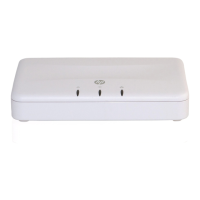36 Working with wireless communities and authentication
Wireless community configuration options
You can configure the following settings for each wireless community:
Network name (SSID)
Specify a name to uniquely identify the wireless network associated with this wireless
community. Each wireless user that wants to connect to this community must use this name.
The name is case-sensitive and must include between 2 and 32 alphanumeric characters,
including spaces. The following characters are not allowed:
• ?, “, $, [, \, ], and +
• only spaces
• #, !, ;,and a space as the first character
• a space as the last character
Broadcast SSID
This option controls whether the network name (SSID) is broadcast to all wireless users.
• When enabled, the wireless network will be visible to wireless clients. Wireless clients are
usually configured to automatically discover APs that broadcast their names and connect to
the one with the strongest signal.
• When disabled, the network will not be visible to wireless clients. Wireless users must
manually specify the network name (SSID) to successfully connect to the network.
VLAN ID
Use this option to set the default VLAN for traffic from this wireless community on the Ethernet
port. All traffic sent/received on the Ethernet port by the wireless community will be assigned to
this VLAN.
Note Depending on the security protocol in use for the wireless community, members may be
assigned to a VLAN other than the default (the default VLAN ID is 1). Client VLAN assignments
from a RADIUS server override the default VLAN assignment.
MAC authentication
This feature enables you to authenticate wireless users based on the MAC addresses of their
wireless devices. Select one of the following authentication methods:
• Disabled: Do not use MAC authentication.
• Local: Use a MAC authentication list that you configure. If you select this option, you must
specify a list of allowed or blocked users on the MAC authentication page. See Local MAC
authentication on page 45 for instructions.
• RADIUS: Use the MAC authentication list on the external RADIUS server. The M210 uses
the RADIUS servers configured for the Security method option selected for this wireless
community. If no RADIUS servers are defined for the selected security method, the global
RADIUS servers are used. See RADIUS server-based MAC authentication on page 44.
By default, no global RADIUS server is defined. To define one or more servers, select
Global RADIUS server settings and configure the RADIUS IP address type,
RADIUS IP address, and RADIUS key.

